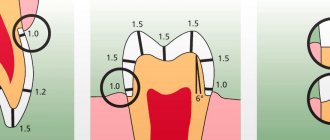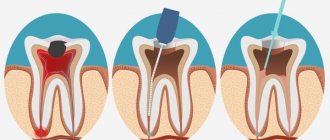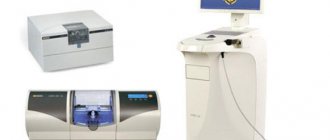Windows Window Tabs
Confused? Now I will explain the difference between these two programs:
- Clover makes tabs in the system Explorer window itself and makes it possible to keep several folders open at the same time in one window, move with one click of the mouse from tab to tab, copy, move files between them. There is no way to open any program in Clover.
- WindowTabs will be able to make several tabs in ONE program window. The title picture of the article shows this function very well - three browsers are open in one window. There is no need to minimize one browser and expand another.
This way you can make tabs on ANY several programs in one window. These tabs can be extended, colored, compressed in height, hidden under the edge of the screen, placed in the center, left or right...
I simply don’t have words to express my admiration for this program. This beauty works like a watch - without glitches, slowdowns or errors.
So, let's download, launch and configure WindowTabs...
In the tab or in the tab, whichever is correct
Tab
(English tab) - an element of the graphical user interface that allows, in one application window, switching between several open documents or predefined sets of interface elements when several of them are available, and only one of them can be shown in the window space allocated for them.
A tab is a “protrusion” with an inscription located on the border of the screen area allocated for removable content. Clicking on a tab makes it active, and the tab-controlled area of the screen displays its corresponding content. The tabs are located one after another horizontally, less often vertically.
In relation to this interface element in settings windows, the name “bookmark” is often used. The original metaphor is bookmarks in a book that give access to certain pages, protruding beyond the boundaries of a block of pages. But when this approach was invented to be used in Internet browsers to manage open pages, this name began to conflict with the concept of “saved link”, which in that context began to be called “bookmarks” in Russian long before this idea. That's why browsers started calling this control "tabs," and it's increasingly being called that in other contexts as well.
A large number of pages of options in application settings dialogs are sometimes controlled not by tabs, but by a linear or hierarchical list located to the left of the settings area. Some applications have the ability to select any of the options for displaying the hierarchy of tab-parameter elements; a prime example is MediaInfo.
The interface of applications that have tabs for managing documents is usually classified as TDI (tabbed document interface). The TDI interface is used in browsers, instant messengers (sessions in Miranda IM, mIRC), clients of file-sharing networks (connections to hubs in DC++) and other applications.
Ushakov's Explanatory Dictionary. D.N. Ushakov. 1935-1940.
See what “TAB” is in other dictionaries:
tab - arch support Dictionary of Russian synonyms. tab noun, number of synonyms: 3 • microprosthesis (3) • ... Dictionary of synonyms
Download WindowTabs
| Name of the program (service): | WindowTabs |
| Manufacturer (author): | Mauricef |
| Status: | For free |
| Category: | Windows interface |
| Installer (archive) size: | 2.95 MB |
| OS support: | Windows XP,7,8,10 |
| Interface language: | English |
| Safety: | No viruses |
| Similar programs/services: | Clover |
| Link to installer/website: |
…
…
The program is portable and does not need to be installed. Just click on the downloaded file and that’s it...
Now the program will permanently live in the tray, next to the clock. Launch any three programs and RIGHT-click on the WindowTabs program shortcut in the tray. Let's go to settings...
Bad habit: not closing browser tabs to “read later”
Most often we just leave the tab open. As soon as the opportunity and desire arise, click on it and read the postponed article - the ideal scenario.
Unfortunately, it almost never materializes in life. There are several deferred articles, the tab bar becomes clogged.
I constantly feel inconvenienced by dozens of open tabs. And they are all left for “reading later.” Reviews of devices, articles from foreign sites, lectures for study - this is the kind of content that you then have to sift through.
Friends of mine have obviously encountered a similar situation. A man looks at my laptop, sees dozens of open tabs and asks: did you leave everything for later? This has happened three times in my life.
Colleague Denis Cherkashin spoke about a similar situation in his own country. Recently, the editor of Aigids closed 47 tabs in his browser, most of them also opened to read later.
Open tabs overload your computer's RAM
The browser requires a lot of RAM space.
When RAM is overloaded, the computer performs worse - it slows down and overheats. In addition, the browser may close itself if it runs out of RAM space.
Chrome is considered the most power-hungry browser, but Make Use Of author Gavin Phillips debunked the theory. He opened the same tabs in five browsers at the same time, Mozilla Firefox and Safari took up more space than Chrome.
It is not always possible to read an article found on the Internet. Business, fatigue, procrastination - there are plenty of reasons why you will put off reading an interesting longread for later.
Using any popular browser, you will experience problems if you do not close tabs on time. All because of their features. They operate primarily in multi-process mode, which requires more gigabytes.
We call tabs web pages, but in reality they are full-fledged web applications.
In simple words: if you have an article, a social network and a video open in three tabs, then you have three different applications open. Therefore, they require more RAM than static web pages. You still won't read open articles
My experience: I consistently have 5-7 tabs open in Chrome with pending articles, and the maximum I read is about three. Most often, I reach 10-12 open pages, after which I freak out and close the browser, because it becomes impossible to use due to a clogged tab bar and loaded RAM.
When I open the browser, I can remember a maximum of three pending articles. The rest are forgotten. Although, leaving the page open, I thought that the material was important to study. Apparently not much.
There is a way to open recent pages: Ctrl + Shift + T on Windows and Command + Shift + T on Mac. But remembering how difficult it was to find the article I needed out of dozens, I don’t do that.
How to deal with the problem?
Sending them as messages to yourself on social networks or leaving them in bookmarks is not an option at all. This way they won’t even bother you, you’ll definitely forget about them.
Therefore, there are two ways to solve the problem:
- self-discipline.
Set myself the condition that by the end of the week I must read all the postponed articles.
Safari in iOS 13 received a useful feature - automatic closing of tabs. On your iPhone, go to Settings -> Safari -> Closing Tabs and choose whether to close pages automatically and after how long.
True, on a desktop the function would not be so relevant.
A computer is still a working device, and you need to be sure that nothing you need will go missing. There are extensions with similar capabilities, like Tab Wrangler, but they are unstable. - humility. I simply admitted that I have no willpower, so I don’t trust myself and don’t expect anything. I will never read all five articles that I save. Therefore, if I leave a tab, then only the necessary one. The rest - basically no. If necessary, I will find it again.
What's good about tabs?
When they are used correctly and tastefully, tabs become an important element of the user interface that makes the site easy to use. And all because:
- They are great metaphors.
In user interface terminology,
metaphor
is an idea or object designed to bring the user and the program closer together and make friends. This is why using tabs makes a great metaphor because they look almost like real tabs in a file cabinet. Thus, the user intuitively understands that tabs divide the content into parts, and, as in real life, by selecting the desired folder in the file cabinet, which on the site corresponds to clicking on a tab, he receives the corresponding part of the data;
Tabs on websites resemble real ones in a file cabinet - They improve data organization.
Tabs divide content into meaningful sections that take up less screen real estate than if they were placed together on the same page at the same time. At the same time, access to data is simple and clear;
On the AirMalta website, tabs effectively separate booking-related data - They are pleasing to the eye.
Properly implemented, tabs can improve the appearance of a site, because thanks to their form and functionality, they become an interesting interface object that is difficult not to notice, but easy to use.
Where did the “Forms in separate windows” setting for 1C: Accounting 8.3, edition 3.0 go?
2017-12-19T18:27:08+00:00
Question from a site reader:
Nowhere on the Internet can I find answers regarding the disappearance of the function from the appearance settings of “forms in separate windows” in the latest releases of Technology Platform 8.3 (disappeared starting from 8.3.10.2168), Power Supply Configuration.
It was like this (in 8.3.9):
This is how it became (in 8.3.10):
Can you tell me how to launch this mode at startup, or how to return this function?
Answer:
1C, starting with version 8.3.10.2168, really removed the ability to enable the “separate windows” mode from the user interface.
But for many users (especially accountants), this interface option in separate windows is really necessary, for example, when you need to open two reports in adjacent windows for more convenient work with them.
I’ll say right away that this feature can no longer be enabled for the web client; this is due to the fact that working in separate windows within one page is not welcomed by modern browsers.
For a thin or thick client, you can return this feature (if you really want) and now we’ll look at how.
To do this, go to the database settings in the 1C starter (by selecting the database and clicking the “Change” button):
Add the /isdi parameter to it
I got it like this:
Click “Finish”.
Now we launch our database in the usual way and enjoy the operating mode in separate windows:
But to our chagrin, some logs and reports will still open in the main program window (and not separately, as we would like).
And now I will show you how to ensure that two reports (for example, 2 balance sheets) open in adjacent (separate) windows.
A separate window with the report opened:
In the same way, open and dock the required number of reports for more convenient work with them:
That's all
Sincerely, Vladimir Milkin (teacher and developer).
In current work, the user usually opens several objects. This could be a document, reference book, report, etc. In the previous interface, there were no problems quickly finding an open object and updating it for further work using windows or tabs.
However, in the Taxi interface, as soon as we open a new document, the previous one is hidden. Searching for it using the Forward-Back arrows is extremely inconvenient. After a long search, a solution was found. Maybe it's not the best.
All Windows
On the system commands panel (this is the top line of the command interface), click on the “Add or remove buttons” button, then click on the “All windows ...” item. The “Window List” button will appear on the system command bar. Clicking on it opens the “All Windows” form, which displays a list of open configuration objects. These can be directories, document forms, journal lists, accumulation registers, information registers, chart of accounts.
Clicking All Windows opens a form with a list of open windows:
In the previous interface, regardless of its appearance “Forms in bookmarks” or “Forms in separate windows”, all open forms were visible: either in bookmarks on the desktop or in the operating system tray.
It was easy for the user to find the desired form. In addition, he clearly saw how carried away he was by the number of open windows. Now, firstly, he must know how to get to the “Window List” button. Secondly, he does not see how many windows are open to him. To do this, he must click on the “Window List” button each time.
Another option: Add a panel of open windows
Click on View > Panel Settings:
I like tabs on top, so I drag the Open panel up and click OK
As a result, a panel of open windows appears at the top.
I often have to interact with 1C developers, and while working together on projects, I notice that not all of them know their main tool well - the “Configurator”. Moreover, this does not apply to the degree of coolness of the developer. As it turned out, even seniors do not use all the capabilities of the Configurator, but they can save a lot of time, and thereby increase the productivity of the developer.
Under the cut, I decided to collect several useful features of the standard configurator, which I use regularly. Many of them appeared in the 1C:Enterprise 8.3.x platform, so before testing, be sure to check the version number of the platform you have installed.
Result of opening a new tab in Google Chrome browser
Any of the methods described above is no better or worse than the other two. Therefore, you should choose which one to use based on your own convenience and habits (and forget the other two) =)
The main thing is to remember that each open browser tab is a part of your computer’s RAM, which will be occupied by storing and processing the information contained in this tab. Therefore, I advise you to close tabs that are not needed.
Well, as a result of any of the actions described above, in any case, a new tab in the Google Chrome browser will open:
Good luck! =)
What is a browser tab?
Every open site in a browser appears in a tab, just as every open program on a computer appears in a window. Typically, this tab is docked to the top bar of the browser, just like program windows open to the taskbar. There can be many open windows, it all depends on the performance of your computer and the size of your monitor. You can change the active tab by clicking LMB on the desired tab.
How to open a new browser tab?
Despite the differences in the interface of different browsers, opening a new tab should be intuitive. Typically, the open new tab button appears next to already open tabs. In the Opera browser, you can open a new tab by clicking on this button:
In the Google Chrome browser it is identical, except that there is no “+” icon on the button
How to drag a site to the taskbar?
We see that all tabs appear in the browser window itself, and the browser is on the taskbar at this time (that is, on the lower horizontal strip). Sometimes it is convenient to highlight one site from all the others and also move it to the taskbar as a separate window. To do this, you need to hover the cursor over the required tab and, by clicking LMB, drag it down, an animation of the tab separating from the browser will immediately appear, after which the tab will appear on the taskbar like this:
Tabs can also be swapped with each other by dragging them.






